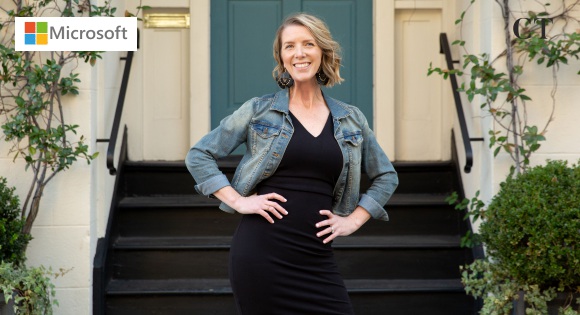The Purposefully Driven Disruptor Leads Higher Education Transformation Innovation for Students of Today and Tomorrow
As a purposefully driven disruptor, Dr. Melissa Hortman does everything intentionally and strategically to challenge the status quo and to create positive change.
Charting Her Path
Dr. Hortman’s path was never meant to lead her to work for big tech. She realized early in her professional journey that she was meant for a path less taken. However, the common thread that has pulled her along through each step of her journey is a fundamental mission to help others and make a positive impact in the world.
As an undergraduate, Dr. Hortman chose Architecture because every space we occupy can affect our mood, productivity, and behavior. As a bonus, this was as far away from education as she could get as her parents were educators and she didn’t want to walk in their footsteps. She had to pave her own path.
Outside of learning about the theory and practice of Architecture, Dr. Hortman worked multiple jobs on campus to help pay her tuition. She learned about the heart of higher education through auxiliary and support services. There was something there for her that aligned with her passions. She decided to pursue a master’s in student affairs to understand higher education more. The layers started to unpeel for her to see how working in higher education could give her purpose in helping others and making a positive impact. She found a love for innovating in teaching and learning, working to pave the path for new programs and initiatives, and being an ally and advocate for inclusivity. She had the privilege of teaching amazing students and mentoring people around her, many of which had more of an impact on her than she had on them.
She then found her personal mission aligning with that of Microsoft, “to empower every person and every organization on the planet to achieve more.” While she does not work within a singular higher education institution, Dr. Hortman gets to lead work across all of higher education. “My goal is to bring higher education and Microsoft closer together because we are both working on solving the same problems, serving the same people, and driving forward a future of transformation and innovation in education,” she says.
Her Work at Microsoft
When Dr. Hortman began to understand the heart of higher education, she became deeply invested in its success. When she joined Microsoft, she wanted to make sure she wasn’t leaving higher education as she knew there is still more work for her to do there. As a Senior Industry Executive at Microsoft, she helps higher education transform for the students of today and tomorrow. Her goal is to empower faculty innovation and student resiliency to make higher education more agile and stronger during disruptions now and in the future. “We live in a time when disruptions are all around us, increasingly more in higher education than there ever was in the past. I work with colleagues across academia to help solve these current challenges and anticipate future needs,” she says.
Another part of Dr. Hortman’s role is driving Microsoft’s strategy in academic research. This is such a fascinating area because, while cloud computing has been around and is available for researchers in higher education, the use of the cloud to accelerate time to science and science to scholarship is becoming more pervasive for all types of research. The cloud is a game-changer for researchers. It can transform their research because what may not have been possible before is possible now. New research questions can be asked. New science can be explored. The possibilities are endless.
Ideas at Work
Dr. Hortman’s role at Microsoft was envisioned to support faculty in their pursuits of teaching, research, and scholarship. She joined Microsoft to build a bridge. Coming from academia, these are her colleagues, and her friends, that are now her customers, and it was important for her to make sure to approach them as such.
Driving strategy along with connecting with customers positions Dr. Hortman to give faculty and researchers a voice within Microsoft. During her tenure, she launched a new approach to the Microsoft Academic Research Community Advisory Board that created a more intimate group of researchers and leaders in the research community who were willing to lean in and truly advise Microsoft on how we could better support this community. As Microsoft works to truly show up for research and accelerate time to science and science to scholarship, Dr. Hortman has a trusted group of advisors she consults with to ensure they are working in the right direction for the academic community.
Taking on Challenges
Dr. Hortman faced challenges as a female in various predominately male fields. From Architecture to big tech and even advanced degrees, she has been one of the few females in those spaces. She has learned how to find her voice and speak up to share another perspective or challenge the status quo. It was incredibly challenging but amazingly liberating. This is where her passion for disruption started. “Your voice is your strongest asset and can use it for driving your personal and professional mission forward,’ she asserts.
Dr. Hortman’s father often told her from a very young age, “if you aren’t having fun, don’t do it”. She has lived by these words in her personal and professional life. “Fun is in the challenges you work to overcome, it’s in the successes you find, it’s in the relationships you build,” she says.
Leveraging Technology
Technology is only as good as the human using it. Dr. Hortman believes technology can never replace a human, but a human using technology can. That is important to remember as the world is quickly changing around us, and we can easily become irrelevant tomorrow with the advancement of technology. Staying current on technology, even if it isn’t directly relevant to one’s role, is imperative as technology is becoming more pervasive across all disciplines.
Dr. Hortman is excited about working with disruptive technologies. “Working in the space of early adoption and emerging capabilities can put you on the bleeding edge. Sometimes you’re successful in your bleeding edge innovations, many times not. While you might be more comfortable in the middle or even at the end of the innovation curve, we must educate ourselves on what is already here and what is coming so we can better anticipate change,” she says.
Throughout her career, Dr. Hortman has used technology as a catalyst to create opportunities to accelerate her ideas, design innovations and processes, and support her in pushing boundaries. She has worked alongside a team to create a wellness PowerApp that scaled to a 30,000+ employee enterprise and created automated workflows for my team so they never had to worry about backup on taking days off.
She has seen amazing people leverage technology to transform education and research in innovative ways. “I’ve seen how cloud technologies can truly transform research in ways she never thought possible. Putting advanced technology in the hands of some of the smartest people in the world, academic researchers, we are seeing bleeding-edge research come to life and answer some of the toughest research questions ever asked. Technology didn’t do the research. Technology didn’t push through boundaries. Researchers empowered with advanced technologies did,” she asserts.
Rewarding Moments
For Dr. Hortman, more than accolades, it has always been important to seek out how she could have an impact. While there have been awards along the way, it’s the stories of impact behind the awards that really stick with her.
Dr. Hortman has impacted higher education by sharing her best practices and research with colleagues. She has delivered keynotes at industry conferences where she presented over 40 peer-reviewed sessions. She was also part of a group that created a novel, international, peer-reviewed journal for faculty to share their innovations in teaching and learning in higher education. She earned a Hero Award in her first year at Microsoft for bringing the faculty voice to all they do at Microsoft. She was nominated to be part of a leadership development program at Microsoft.
While professional impacts are important, personal pursuits of impact are equally as important for Dr. Hortman. After having conversations with colleagues across Microsoft, she discovered there wasn’t proactive communication for higher education faculty. She aimed to change that with a LinkedIn newsletter called “On Track with MicrosoftEDU” where she highlights a colleague in academia, shares timely resources and brings together all the Microsoft opportunities and events for faculty. Finally, she recently completed the Disney “Dopey” Challenge, which consists of a 5K, 10K, half marathon, and full marathon completed in consecutive days. “This is the second time I’ve completed this running challenge, once before I had my two children and now once after. It was amazing to see my kids hold up signs of encouragement like ‘My mom is awesome!’ and “Run, mommy, run!” she exclaims.
On the Cards
Dr. Hortman’s goal is to showcase Microsoft’s value in technology across all roles in higher education, and by expanding its market to end-users across campus, innovative opportunities can be discovered throughout the institution. She truly believes in Microsoft’s mission to empower every person and organization on the planet to achieve more. Growth at Microsoft in higher education means empowering every student, every faculty member, and every administrator with the tools so they can excel in their respective roles and contribute to the overall success of their institution.
Expanding the research enterprise and research excellence are areas of interest across all higher education because while the advancement of knowledge is important, it is equally important to grow funding sources for higher education. With only 2.57% of institutions having R1 (very high research activity) classification in the U.S., there are 4,383 other institutions that are striving to grow their research enterprises (per 2021 data of the Carnegie Classifications of Institutions of Higher Education). Dr. Hortman’s goal is to bring Microsoft alongside to support 100% of the institutions who want to grow their research enterprise by transforming research infrastructure to expand options for faculty’s research initiatives, foster a culture of research where the institution can strive to move to or retain R1 classification, and build a vision for leading innovation and discovery that will drive economic growth and development in their communities and regions.
Words for the Next Gen Disruptors
“As the world around us is changing constantly, Dr. Hortman would challenge the next generation, in any organization or domain, to disrupt or be disrupted. Change is constant so it is important to be agile in one’s work and approaches.
As higher education moves into the next decade, the transformation will need to be considered in higher education from admissions processes to communicating and collaborating with individuals and teams. Leaders can inspire and influence transformation all while providing stability during change. Thus, transformational leaders can create a clear and inspiring vision that they can effectively communicate to others while also being focused on the growth and development of individuals on their teams. If the disruption of COVID-19 has taught the next generation of higher education leaders anything, it is that they can overcome very challenging times and come out on the other side stronger for themselves, their team, and the students they serve. Those are the leaders of tomorrow that I am excited about leaning into transformation for all of higher education,” concludes Dr. Hortman.






